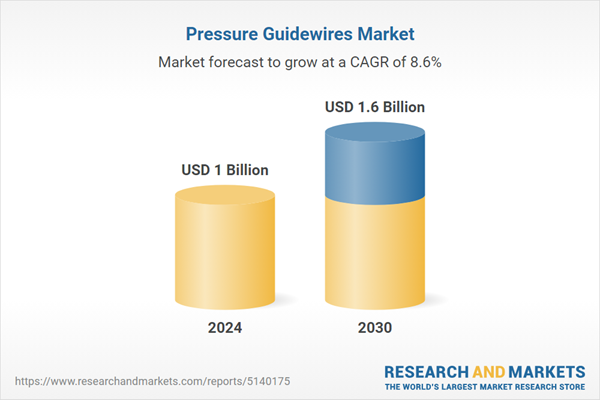The global market for Pressure Guidewires was valued at US$1.0 Billion in 2024 and is projected to reach US$1.6 Billion by 2030, growing at a CAGR of 8.6% from 2024 to 2030. This comprehensive report provides an in-depth analysis of market trends, drivers, and forecasts, helping you make informed business decisions. The report includes the most recent global tariff developments and how they impact the Pressure Guidewires market.
How Are Technological Advancements Enhancing Pressure Guidewires?
Technological advancements have significantly enhanced the functionality and reliability of pressure guidewires, making them more effective tools in the diagnosis and treatment of cardiovascular conditions. Innovations in sensor technology have led to the development of highly sensitive and miniaturized pressure sensors that can provide real-time, accurate measurements even in the smallest coronary arteries. The integration of advanced materials such as hydrophilic coatings and flexible alloys has improved the maneuverability and durability of pressure guidewires, enabling them to navigate through complex and tortuous arterial pathways with ease. Additionally, the development of wireless pressure guidewires has eliminated the need for cumbersome connections, allowing for more streamlined procedures and greater patient comfort. These technological improvements have expanded the capabilities of pressure guidewires, making them essential tools in modern cardiology.
Segments: End-Use (Hospitals, Ambulatory Surgical Centers, Independent Catheterization Labs); Product Type (Flat Tipped Pressure Guidewires, Flexible Tip Pressure Guidewires); Technology (Pressure Wire Technology, Optical Fiber Technology).
Geographic Regions/Countries: World; United States; Canada; Japan; China; Europe (France; Germany; Italy; United Kingdom; and Rest of Europe); Asia-Pacific; Rest of World.
The analysts continuously track trade developments worldwide, drawing insights from leading global economists and over 200 industry and policy institutions, including think tanks, trade organizations, and national economic advisory bodies. This intelligence is integrated into forecasting models to provide timely, data-driven analysis of emerging risks and opportunities.
Global Pressure Guidewires Market - Key Trends and Drivers Summarized
Pressure Guidewires: Precision Tools for Cardiovascular Diagnostics
Pressure guidewires are specialized medical devices used primarily in the diagnosis and treatment of coronary artery disease (CAD). These thin, flexible wires are equipped with pressure sensors at their tips, allowing them to measure blood pressure and flow within the coronary arteries. The data obtained from pressure guidewires helps cardiologists assess the severity of arterial blockages and determine the necessity of interventions such as angioplasty or stenting. Unlike traditional angiography, which provides only visual images of blood vessels, pressure guidewires offer functional information, giving a clearer understanding of how blockages affect blood flow. This precision makes them invaluable in ensuring that patients receive the most appropriate and effective treatment, reducing the risk of unnecessary procedures and improving overall patient outcomes.How Are Technological Advancements Enhancing Pressure Guidewires?
Technological advancements have significantly enhanced the functionality and reliability of pressure guidewires, making them more effective tools in the diagnosis and treatment of cardiovascular conditions. Innovations in sensor technology have led to the development of highly sensitive and miniaturized pressure sensors that can provide real-time, accurate measurements even in the smallest coronary arteries. The integration of advanced materials such as hydrophilic coatings and flexible alloys has improved the maneuverability and durability of pressure guidewires, enabling them to navigate through complex and tortuous arterial pathways with ease. Additionally, the development of wireless pressure guidewires has eliminated the need for cumbersome connections, allowing for more streamlined procedures and greater patient comfort. These technological improvements have expanded the capabilities of pressure guidewires, making them essential tools in modern cardiology.
What Are the Key Applications and Benefits of Pressure Guidewires?
Pressure guidewires are used in various interventional cardiology procedures, offering numerous benefits that enhance the accuracy and safety of cardiovascular diagnostics and treatments. The primary application of pressure guidewires is in fractional flow reserve (FFR) measurements, where they help determine the hemodynamic significance of coronary artery stenoses. By accurately measuring the pressure gradient across a blockage, FFR can guide decision-making on whether to perform revascularization procedures, thus ensuring that only functionally significant lesions are treated. Pressure guidewires are also used in assessing microvascular resistance and evaluating the effectiveness of coronary interventions. The benefits of using pressure guidewires include improved diagnostic accuracy, reduced risk of unnecessary procedures, and better patient outcomes. By providing critical functional data that complements anatomical imaging, pressure guidewires play a crucial role in the management of coronary artery disease.What Factors Are Driving the Growth in the Pressure Guidewires Market?
The growth in the pressure guidewires market is driven by several factors. The increasing prevalence of cardiovascular diseases, particularly coronary artery disease, is a significant driver, as pressure guidewires are essential tools in diagnosing and treating these conditions. Technological advancements that enhance the sensitivity, durability, and ease of use of pressure guidewires are also propelling market growth. The growing emphasis on precision medicine and the need for accurate, patient-specific diagnostic tools are further boosting the demand for pressure guidewires. Additionally, the expansion of interventional cardiology services, coupled with the rising adoption of minimally invasive procedures, is contributing to market growth. The increasing availability of training programs and the growing awareness among healthcare providers about the benefits of pressure guidewires are also supporting market expansion. These factors, combined with continuous innovation in guidewire technology, are driving the sustained growth of the pressure guidewires market.Report Scope
The report analyzes the Pressure Guidewires market, presented in terms of units. The analysis covers the key segments and geographic regions outlined below.Segments: End-Use (Hospitals, Ambulatory Surgical Centers, Independent Catheterization Labs); Product Type (Flat Tipped Pressure Guidewires, Flexible Tip Pressure Guidewires); Technology (Pressure Wire Technology, Optical Fiber Technology).
Geographic Regions/Countries: World; United States; Canada; Japan; China; Europe (France; Germany; Italy; United Kingdom; and Rest of Europe); Asia-Pacific; Rest of World.
Key Insights:
- Market Growth: Understand the significant growth trajectory of the Flat Tipped Pressure Guidewires segment, which is expected to reach US$1.0 Billion by 2030 with a CAGR of a 8.1%. The Flexible Tip Pressure Guidewires segment is also set to grow at 9.6% CAGR over the analysis period.
- Regional Analysis: Gain insights into the U.S. market, valued at $280.0 Million in 2024, and China, forecasted to grow at an impressive 8.1% CAGR to reach $252.0 Million by 2030. Discover growth trends in other key regions, including Japan, Canada, Germany, and the Asia-Pacific.
Why You Should Buy This Report:
- Detailed Market Analysis: Access a thorough analysis of the Global Pressure Guidewires Market, covering all major geographic regions and market segments.
- Competitive Insights: Get an overview of the competitive landscape, including the market presence of major players across different geographies.
- Future Trends and Drivers: Understand the key trends and drivers shaping the future of the Global Pressure Guidewires Market.
- Actionable Insights: Benefit from actionable insights that can help you identify new revenue opportunities and make strategic business decisions.
Key Questions Answered:
- How is the Global Pressure Guidewires Market expected to evolve by 2030?
- What are the main drivers and restraints affecting the market?
- Which market segments will grow the most over the forecast period?
- How will market shares for different regions and segments change by 2030?
- Who are the leading players in the market, and what are their prospects?
Report Features:
- Comprehensive Market Data: Independent analysis of annual sales and market forecasts in US$ Million from 2024 to 2030.
- In-Depth Regional Analysis: Detailed insights into key markets, including the U.S., China, Japan, Canada, Europe, Asia-Pacific, Latin America, Middle East, and Africa.
- Company Profiles: Coverage of players such as Abbott, Amayeza Abantu Bio-Medical (Pty) Ltd, Asahi Intecc Co., Ltd., B. Braun Melsungen AG, BD and more.
- Complimentary Updates: Receive free report updates for one year to keep you informed of the latest market developments.
Some of the 42 companies featured in this Pressure Guidewires market report include:
- Abbott
- Amayeza Abantu Bio-Medical (Pty) Ltd
- Asahi Intecc Co., Ltd.
- B. Braun Melsungen AG
- BD
- Boston Scientific Corporation
- Cardinal Health
- Cook
- Johnson & Johnson Services, Inc.
- Koninklijke Philips N.V.
- Medtronic
- Merit Medical Systems
- Olympus Corporation
- Opsens Medical
- Stryker
- Teleflex Incorporated
- Terumo Corporation
Tariff Impact Analysis: Key Insights for 2025
Global tariff negotiations across 180+ countries are reshaping supply chains, costs, and competitiveness. This report reflects the latest developments as of April 2025 and incorporates forward-looking insights into the market outlook.The analysts continuously track trade developments worldwide, drawing insights from leading global economists and over 200 industry and policy institutions, including think tanks, trade organizations, and national economic advisory bodies. This intelligence is integrated into forecasting models to provide timely, data-driven analysis of emerging risks and opportunities.
What’s Included in This Edition:
- Tariff-adjusted market forecasts by region and segment
- Analysis of cost and supply chain implications by sourcing and trade exposure
- Strategic insights into geographic shifts
Buyers receive a free July 2025 update with:
- Finalized tariff impacts and new trade agreement effects
- Updated projections reflecting global sourcing and cost shifts
- Expanded country-specific coverage across the industry
Table of Contents
I. METHODOLOGYII. EXECUTIVE SUMMARY2. FOCUS ON SELECT PLAYERSIII. MARKET ANALYSISCANADAITALYREST OF EUROPEREST OF WORLDIV. COMPETITION
1. MARKET OVERVIEW
3. MARKET TRENDS & DRIVERS
4. GLOBAL MARKET PERSPECTIVE
UNITED STATES
JAPAN
CHINA
EUROPE
FRANCE
GERMANY
UNITED KINGDOM
ASIA-PACIFIC
Companies Mentioned (Partial List)
A selection of companies mentioned in this report includes, but is not limited to:
- Abbott
- Amayeza Abantu Bio-Medical (Pty) Ltd
- Asahi Intecc Co., Ltd.
- B. Braun Melsungen AG
- BD
- Boston Scientific Corporation
- Cardinal Health
- Cook
- Johnson & Johnson Services, Inc.
- Koninklijke Philips N.V.
- Medtronic
- Merit Medical Systems
- Olympus Corporation
- Opsens Medical
- Stryker
- Teleflex Incorporated
- Terumo Corporation
Table Information
| Report Attribute | Details |
|---|---|
| No. of Pages | 194 |
| Published | April 2025 |
| Forecast Period | 2024 - 2030 |
| Estimated Market Value ( USD | $ 1 Billion |
| Forecasted Market Value ( USD | $ 1.6 Billion |
| Compound Annual Growth Rate | 8.6% |
| Regions Covered | Global |









